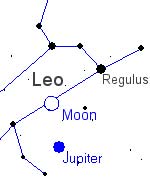
Image credit: NASA
Lately Earth and Jupiter have been approaching one another, and this week the two worlds are only 400 million miles apart. That’s what astronomers call “a close encounter.”
400 million miles is close–on the vast scale of the solar system. Consider Pluto. It’s nearly ten times farther away than Jupiter. Or Saturn. The ringed planet is 800 million miles away. Nevertheless, Saturn looks wonderful right now, and Jupiter is even better.
400 million miles makes Jupiter ten times brighter than Saturn, and twenty-five times brighter than a 1st magnitude star. It outshines everything else in the sky except Venus, the Moon and the Sun.
See for yourself.
Step outside after sunset any night this week and look east. Jupiter is that very bright “star” near the horizon–not to be confused with even brighter Venus in the west. By 9 p.m. Jupiter will be high in the eastern sky, simply dazzling.
On March 4th, the date of closest approach, and March 5th, Jupiter will appear right beside the full Moon in the constellation Leo. So you won’t need a sky map to find Jupiter, just look for the Moon.
If you have a telescope, point it at Jupiter. Even a small ‘scope will reveal Jupiter’s rust-colored cloud belts and its four largest moons. Io, Europa, Callisto and Ganymede look like a dim line of stars straddling the giant planet. Sometimes only two or three moons are visible. That’s because one or two of them are behind Jupiter. Look again later or perhaps tomorrow. The missing moons will come out of hiding as they circle their planet.
The four “Galilean satellites”–so named because they were first observed by Galileo Galilei in 1610–are among the weirdest worlds in the solar system. Io looks like a pizza, and it has active volcanoes that spew sulfurous snow. Europa and Callisto are icy places, hiding, perhaps, the biggest oceans in the solar system beneath their frozen crusts. Ganymede is simply big–larger than Pluto and Mercury, and almost as wide as Mars. If it orbited the sun instead of Jupiter, Ganymede would be considered a full-fledged planet.
Sometimes you can see dark spots creeping across Jupiter. These are shadows cast by the four big moons. Sky & Telescope magazine publishes a schedule of shadow crossings, so you can find out when to look. The crossings are fun to watch through a telescope.
Another thing to look for is Jupiter’s Great Red Spot–a cyclone twice the size of Earth, and at least 100 years old. It swirls across Jupiter’s middle approximately every 10 hours. Again, check Sky & Telescope for viewing times.
First-time observers of Jupiter, squinting through the eyepiece of a small telescope, don’t always believe what they see. The giant planet looks slightly squashed. Is there something wrong with the optics? No, Jupiter really is flattened. The giant planet, 11 times wider than Earth, spins on its axis in only 9 hours and 55 minutes. Speedy rotation gives Jupiter an equatorial bulge. The “squash” is real.
So is the pizza moon, the giant cyclone, the alien oceans. They’re all just 400 million miles away. This is a close encounter you won’t want to miss.
Original Source: NASA Science Story
